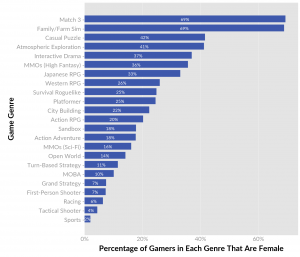Difference between revisions of "First Person Shooters"
(→History) |
(→Embedded Values) |
||
| Line 16: | Line 16: | ||
</ref>. | </ref>. | ||
====Embedded Values==== | ====Embedded Values==== | ||
| − | + | In first-person shooters, the player is able to distinguish the promotion of values including violence and aggression, and demotion of moral values pertaining to empathy. These embedded values are not necessarily a reflection of the values held by game creators, such as in other violent games like [[Manhunt]]. Evidence of these embedded values of first-person shooters are present in studies, which have indicated that video game players often idolize the aggressive and violent character traits of the protagonists in violent video games, or emotionally desensitize the players of violent video games.<ref name="violence study">Konijn, Elly A., et al. “I Wish I Were a Warrior: The Role of Wishful Identification in the Effects of Violent Video Games on Aggression in Adolescent Boys.” Developmental Psychology, vol. 43, no. 4, 2007, pp. 1038–1044., doi:10.1037/0012-1649.43.4.1038.</ref><ref name="empathy study">“Violent Games Emotionally Desensitizing.” Violent Games Emotionally Desensitizing - Universität Bonn, www.uni-bonn.de/Press-releases/violent-games-emotionally-desensitizing.</ref> The act of shooting can also be seen as a built-in consequence to first-person shooters and as a result can make them an aggressive genre of video games.<ref name ="values in design"></ref> | |
==== Value Destruction==== | ==== Value Destruction==== | ||
Revision as of 16:23, 11 April 2019
A First-Person Shooter (FPS) is a video game genre in which the user plays the main character in the first person perspective, using firearms as the main form of gameplay. FPS games can may be single story modes, co-operative story modes, or in multiplayer arenas that connect remote players together via an online network. After the introduction of FPS games with Doom and Wolfenstein 3D, first-person shooters have become risen to become the most popular video game genre. The increasing popularity and ever growing player base (especially of young users) have many people wondering about the ethics of first-person shooters -- largely in regards to violence and gender discrimination in marketing.
Contents
History
While the earliest versions of first person shooting games can be accredited to the games Maze War and Spasim in the year 1974 [1], the main rise to popularity of the genre was coined with the games Wolfenstein and Doom [1]. These games were the first to employ modern graphics and mechanics and were followed by numerous other successful first-person shooting games near the end of the 1990s like Duke Nukem 3D, Quake, and Counter-Strike.The earliest version of first-person shooter games were strictly on PC, but the expansion of the genre to console gaming opened an entirely new audience to first-person shooting games. Halo:Combat Evolved released in 2001, and displayed the powers of FPS games using the Xbox console. Halo’s success paved the groundwork for the development and focus of game companies of producing first-person shooters for console gaming, and the widespread success of the first-person shooting genre.
Online Multiplayer
The popularity of first-person shooting games saw a marked increase with the addition of online multiplayer modes. Services like Xbox Live expanded the market for simpler connections of players to an online service, as games before like Quake and Counter-Strike typically faced issues with slow connections and dial-up broadband services. Halo 3, a first-person shooter developed by Bungie, was able to use the online aspect of Xbox live to make their multiplayer mode be widely successful. The same year Call of Duty 4: Modern Warfare, released with similar success to its online mode. These games are coined with helping pioneer the online rise of first-person shooters and serving as a template for future first-person shooters with multiplayer options.
The addition and widespread use of multiplayer and online modes have also led to a rise in competitive gaming and E-sports, as players of first-person shooters are able to play each other on a global scale.
Ethical Implications
Promotion of Violence

Embedded Values
In first-person shooters, the player is able to distinguish the promotion of values including violence and aggression, and demotion of moral values pertaining to empathy. These embedded values are not necessarily a reflection of the values held by game creators, such as in other violent games like Manhunt. Evidence of these embedded values of first-person shooters are present in studies, which have indicated that video game players often idolize the aggressive and violent character traits of the protagonists in violent video games, or emotionally desensitize the players of violent video games.[5][6] The act of shooting can also be seen as a built-in consequence to first-person shooters and as a result can make them an aggressive genre of video games.[4]
Value Destruction
In Ron Eglash's piece, "A Generative Perspective on Engineering: Why the Destructive Force of Artifacts Is Immune to Politics: Interplay between Engineering, Social Sciences, and Innovation", he examines the many ways that current engineers are creating technologies that are destructive to the values of society[7]. First-person shooters designed to represent highly violent scenarios impacting the values of its players to promote digital violence falls into Eglash's description of an artifact with a destructive force on society. However, the generative approach he describes towards engineering practices could be the solution to the current state of game design. A study on video games found that playing video games has "the potential to enhance life satisfaction and improve individual player’s mental well-being", which indicates first-person shooters and generative forces on society are not mutually exclusive. [8] Proper and conscious game design then should be mitigated towards these game designs which pose ethical concerns to violence.
Bias towards Genders
While first-person shooters may be the most popular video game genre, female players only make up 7% of the players of first-person shooters [9]. Such a drastic disparity in demographics has sparked questions as to why the first person shooter genre is so one-sided towards male players. However, nearly double this amount of women, 17%, have been recorded playing the game Overwatch[10], which has been accredited with a more gender-balanced game design (yet still faces challenges and bias in its design).The disparity in female gamers between Overwatch and other first-person shooters portrays the importance of game design in determining gender bias within video games. This bias in first-person shooters can first be attributed to the values of those designing them. In the game industry, women only make up 22% of the workforce[11]. Expressive values are defined as representing the values of the designers.[4] Since the workforce in the game industry is primarily male, the expressive values within games would have drastic disparities in the representation of genders in their design compared to a more evenly distributed workforce.
In one study of first-person shooters, for example, it was found that 19% of the games used a female avatar as the main playable character[12]. The other 81% of games in this study enforced that the user play with a male avatar. It also outlined that PC games were generally more gender restrictive in the use of avatars compared to console games.[12] Furthermore, the study found that from 1991 to 2009, only 21% of first-person shooters even made playing as a female avatar possible.[12] This study outlines the role game design plays in gender bias.
To find what the implications of what this bias creates, one can look at the final game designs and the values within them. Utilizing the concept of embedded values as a lens to view what these games are promoting, it is apparent that first-person shooters often promote things like male protagonists, overly sexualized female character models, and reinforce gender stereotypes [4]. These embedded values within the design of first-person shooters can impact the personal values which players of these games have. Studies have revealed that playing violent shooting games decreases empathy of violence towards females and creates increased masculine beliefs in its players[13]. This evidence of first-person shooters impacting a player's value system indicates that if left unaltered, the current state of these games will promote values of sexism, stereotyping, and bias in its players. As there are millions of players for first-person shooters, these embedded values then pose a threat to maintaining negative cultural sex roles and stereotypes of genders across a huge scale of players.
References
- ↑ 1.0 1.1 Staff, GamesRadar. “A 43-Year History of First-Person Shooters - from Maze War to Destiny 2.” Gamesradar, GamesRadar+ The Games, Movies and TV You Love, 1 May 2017, www.gamesradar.com/bullets-bombs-history-first-person-shooters/.
- ↑ Bailey, Dustin. “Check out These Gloriously Gory Doom Eternal Screenshots.” PCGamesN, www.pcgamesn.com/doom-eternal/doom-eternal-screenshots.
- ↑ Lindsay, Emma. “The Trouble with First Person Shooters Is Deeper than First Person Shooting.” Medium, Medium, 5 Mar. 2018, medium.com/@emmalindsay/the-trouble-with-first-person-shooters-is-deeper-than-first-person-shooting-157888e66807.
- ↑ 4.0 4.1 4.2 4.3
- ↑ Konijn, Elly A., et al. “I Wish I Were a Warrior: The Role of Wishful Identification in the Effects of Violent Video Games on Aggression in Adolescent Boys.” Developmental Psychology, vol. 43, no. 4, 2007, pp. 1038–1044., doi:10.1037/0012-1649.43.4.1038.
- ↑ “Violent Games Emotionally Desensitizing.” Violent Games Emotionally Desensitizing - Universität Bonn, www.uni-bonn.de/Press-releases/violent-games-emotionally-desensitizing.
- ↑ Eglash, Ron. (2018). A Generative Perspective on Engineering: Why the Destructive Force of Artifacts Is Immune to Politics: Interplay between Engineering, Social Sciences, and Innovation. 10.1007/978-3-319-91134-2_9.
- ↑ Jones, Christian M et al. “Gaming well: links between videogames and flourishing mental health.” Frontiers in psychology vol. 5 260. 31 Mar. 2014, doi:10.3389/fpsyg.2014.00260
- ↑ Yee, Nick. “Beyond 50/50: Breaking Down The Percentage of Female Gamers By Genre.” Quantic Foundry, 14 June 2018, quanticfoundry.com/2017/01/19/female-gamers-by-genre/.
- ↑ McKeand, Kirk. “Twice the Number of Women Play Overwatch than Any Other FPS.” PCGamesN, www.pcgamesn.com/overwatch/overwatch-female-player-count.
- ↑ O'Brien, Lucy. “Women in Video Game Development in 2017: A Snapshot.” IGN, IGN, 20 Dec. 2017, www.ign.com/articles/2017/12/20/women-in-video-game-development-in-2017-a-snapshot.
- ↑ 12.0 12.1 12.2 Hitchens, Michael. “Game Studies.” Game Studies - A Survey of First-Person Shooters and Their Avatars, gamestudies.org/1103/articles/michael_hitchens.
- ↑ Gabbiadini, Alessandro, et al. “Acting like a Tough Guy: Violent-Sexist Video Games, Identification with Game Characters, Masculine Beliefs, & Empathy for Female Violence Victims.” Plos One, vol. 11, no. 4, 2016, doi:10.1371/journal.pone.0152121.

